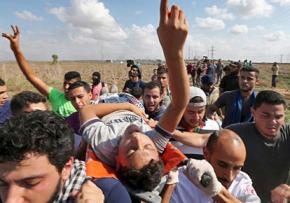The old city of Jerusalem is like a ghost town
Israel has escalated its repression of Palestinians. Mobs of extremists chanting "Death to Arabs" are marauding through the streets in search of Palestinians to attack, and Israeli authorities have banned Palestinians from the Al-Aqsa Mosque, a replay of the provocation by former Israeli Prime Minister Ariel Sharon in September 2000 that led to the second Palestinian Intifada, or uprising.
But to judge from U.S. media coverage, the main threat of violence comes from Palestinians. Several New York Times articles have focused on attacks against Israeli Jews, while barely mentioning the obscene levels of violence directed against Palestinians or the overall context of military occupation. While the Times reports that seven Israeli Jews have been killed since the beginning of October, Israeli soldiers killed six Palestinians in Gaza in a single incident when they fired on a crowd of protesters throwing rocks and rolling burning tires near the fence that separates Gaza from Israel. There were at least 120 attacks by right-wing settlers on Palestinians during the same time period. Since October 3, 21 Palestinians have been killed by Israeli forces, and nearly 1,600 have been injured.
In this eyewitness report published last week, after the first weekend of October, at the revolutionary socialism in the 21st century website, describes the volatile situation in Jerusalem.
THIS AFTERNOON, I went to the old city of Jerusalem.
It is like a ghost town. Very few Palestinians in the streets, many shops are closed, and so are most entries to Al-Aqsa. The passages that remain open are heavily policed, with only those above 55 and tourists allowed in. The streets are full of mobile checkpoints. Each street corner is occupied by a crowd of "police officers" who are basically soldiers in a different uniform. Israeli settlers are all over the place, in all neighborhoods, walking in small groups--armed, confident, jubilant. In the street where two armed settlers were killed on Saturday, a large crowd of their accomplices were holding a sit-in: guitars, songs, candles and flags, as well as signs in English and Hebrew calling for revenge, for retaliation, for justice. They laugh and chat, for the most part in perfect North American English accents--or terrible Hebrew--about "their neighborhood," "their land," "their houses."
The whole area is tense, either very quiet or very loud. It feels ready to explode at any moment. The occupier is present with all its might. They also look ready to stay for a long time. Regular shift changes and police trucks full of water and food keep the soldiers going. Somehow, many tourists continue their tours, admiring the beauty of the buildings, as if totally oblivious to the horror around them.

It is now an open question what will happen to Al-Aqsa. It has effectively been turned into a restricted area, except for tourists, an attraction. Will the state replay the trick it performed in Al Khalil (Hebron in Hebrew), the West Bank city partitioned into Palestinian and Israeli sectors, and separate the holy place in two? One part for Jews and one for Muslims? It seems like way more than a theoretical possibility.
ACROSS THE West Bank and Jerusalem, people are getting organized and fighting back. We are nowhere near the third Intifada so many are announcing on social media in the hope that it will happen, but a shift seems to be taking place. Yesterday in Ramallah, the PLO and the Islamic Front released a joint statement calling for the formation of popular committees of self-defense. People are fighting the army up and down the West Bank and East Jerusalem. Palestinians in Haifa have organized solidarity demonstrations. Schools in the Bethlehem area went on strike today in response to the army's murder of Abdel Rahman Shadi, a 13-year-old boy, in the Aida refugee camp. All universities in the West Bank, occupied Jerusalem and the Gaza Strip are also on strike for better conditions today for the third time in a week.
The Palestinian Authority continues its role as an outsourced Israeli police force, with President Mahmoud Abbas calling on the police to crush the demonstrations as quickly as possible. The Israeli army is increasing its attacks, and over 500 Palestinians have been injured, with up to nine, as far as I know, killed in the last 72 hours. Israeli mobs are attacking Palestinians in the streets and shops of Jerusalem. Netanyahu is whipping up his men by extending repressive measures, encouraging police and soldiers to shoot to kill anyone throwing a Molotov cocktail or even a stone. The authorities have demolished the family homes of two "terrorists" in East Jerusalem. On Sunday evening, the Israelis killed 18-year-old Huthayfa Othman Suleiman and claimed he was responsible for his own death before attacking his family and his entire university. Netanyahu is using the opportunity to repress Hamas in the West Bank, and even to launch air strikes on Gaza two nights ago.
Zionism is unleashing its military power once more on the Palestinian population, and the West continues to foot the bill and support the colonial project. Demonstrations, actions and BDS campaigns should pop up across the globe in response to this situation. It won't free Palestine or stop the current onslaught, but it can continue to increase the pressure on our leaders and their Israeli friends. It can make clear that the world is not only watching, but fighting back, in solidarity with the struggle of the Palestinian people, against colonialism and racial supremacy.
First published at the rs21 website.


